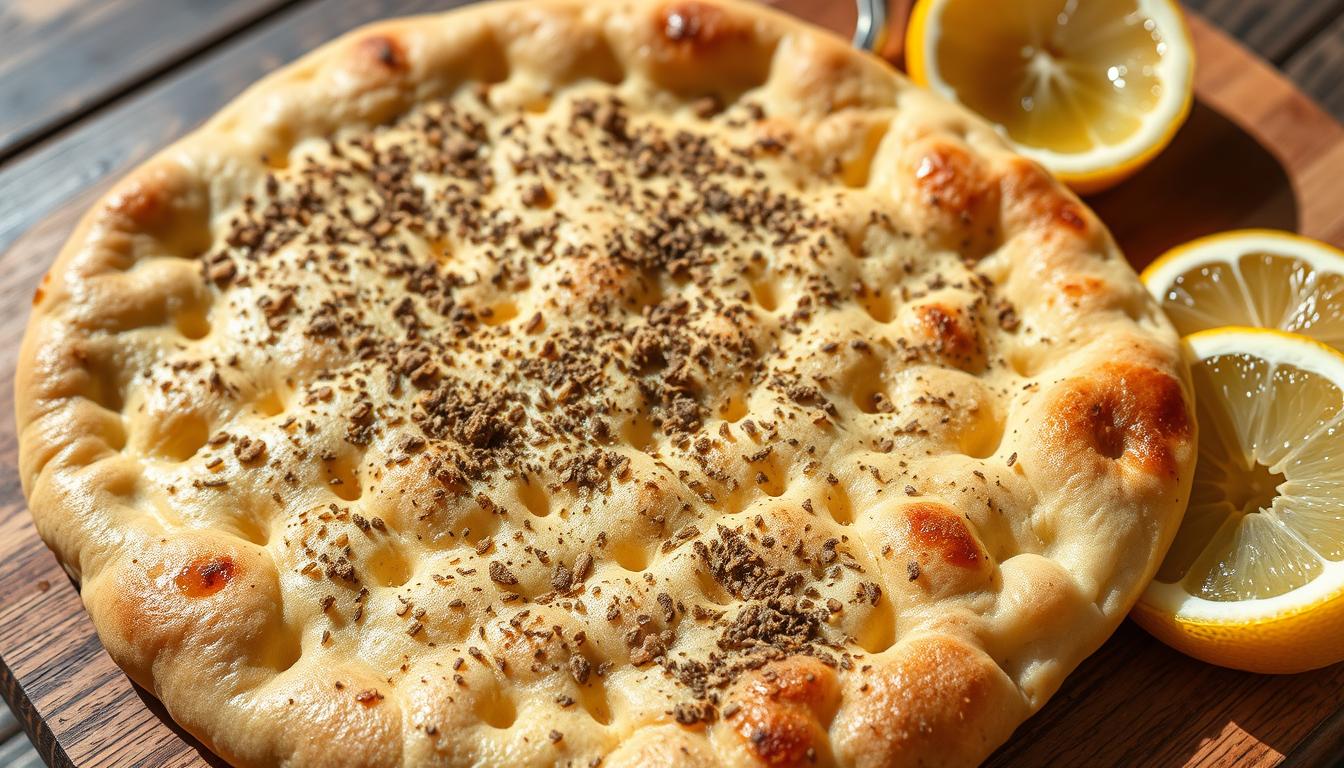Imagine a warm, aromatic manakeesh flatbread fresh from the oven. Its crispy crust turns soft and airy inside. This experience is key to Middle Eastern cuisine, uniting people across cultures and ages.
On this culinary adventure, you’ll uncover the dish’s rich cultural value. You’ll learn to make this tasty mediterranean flatbread at home. It’s simple yet rich, making it a great addition to any meal.
Key Takeaways
- Discover the cultural significance of Manakeesh flatbread in Middle Eastern cuisine.
- Learn how to make delicious Manakeesh at home.
- Explore the simplicity and richness of this beloved dish.
- Understand the joy it brings to those who taste it.
- Enhance your meal repertoire with this perfect addition.
What is Manakeesh Flatbread?
Manakeesh flatbread is deeply rooted in Middle Eastern culture. It’s more than a meal; it’s an experience. This Lebanese flatbread is loved worldwide for its tasty flavors and versatility. You can enjoy it as a snack, side dish, or main course, depending on the toppings.

Manakeesh is closely linked to Lebanon’s rich culinary traditions and the Middle East. Its making and eating are part of the region’s cultural fabric.
The Cultural Significance of Manakeesh
Manakeesh is a key part of Middle Eastern culture. It’s often at the heart of social gatherings and family meals. Making Manakeesh, from dough to toppings, is a loving process that unites people. Enjoy the warmth of Middle Eastern hospitality with a freshly baked Manakeesh, topped with za’atar, cheese, or minced meat.
Regional Variations Across the Middle East
Traveling the Middle East, you’ll find Manakeesh varies greatly. Each region has its own toppings and ingredients, showing local tastes and preferences. Here’s a look at some of these variations:
| Region | Common Toppings | Special Ingredients |
|---|---|---|
| Lebanon | Za’atar, olive oil | Sumac |
| Syria | Minced meat, onions | Pine nuts |
| Jordan | Cheese, thyme | Garlic |
These variations highlight Manakeesh’s diversity and richness. It offers a culinary journey worth exploring.
Essential Ingredients for Authentic Manakeesh
The secret to delicious Manakeesh is in its simple, high-quality ingredients. To make authentic Manakeesh, focus on the dough and traditional toppings. These give it a unique flavor.
The Perfect Dough Components
For the dough, you’ll need warm water, active dry yeast, flour, salt, and a bit of olive oil. High-quality flour, like bread flour or all-purpose flour with high protein, is key for the right texture.
Traditional Toppings and Seasonings
Manakeesh toppings can vary, but traditional ones include Za’atar, cheese, and minced meat. The secret to a great Manakeesh is balancing these toppings with the right seasonings. Common seasonings are sumac, thyme, and a pinch of salt.

Za’atar: The Signature Spice Blend
Za’atar is a mix of herbs like thyme, oregano, marjoram, and toasted sesame seeds, with sumac. It’s the signature flavor of Manakeesh. It’s often mixed with olive oil before being spread on the dough. The quality of Za’atar greatly affects the taste of your Manakeesh.
- High-quality Za’atar
- Fresh ingredients for toppings
- Good quality flour for the dough
Equipment You’ll Need for Making Manakeesh
Before you start making Manakeesh, you need to get the right tools. To make a true traditional flatbread, you’ll need a few key items.
Traditional vs. Modern Baking Methods
Traditionally, Manakeesh is baked in a wood-fired oven or on a baking stone. But, you can also use a regular oven with a baking steel or stone. Skillets or non-stick baking sheets work too.
Substitutions for Specialized Equipment
If you don’t have a baking stone or oven, don’t fret. You can still make tasty Manakeesh with common kitchen tools. Here’s a look at some alternatives:
| Equipment | Traditional Use | Modern Alternative |
|---|---|---|
| Baking Surface | Baking Stone | Non-stick Baking Sheet |
| Oven Type | Wood-fired Oven | Conventional Oven |
| Cooking Vessel | Tabun or Tannur | Skillet or Cast Iron Pan |
Step-by-Step Manakeesh Flatbread Recipe
To make an authentic Manakeesh, follow this detailed recipe. It guides you through each step. With your ingredients ready and equipment in hand, you’re set to make your Manakeesh flatbread.
Preparing the Perfect Dough
The key to a great Manakeesh is its dough. Start by mixing 2 cups of warm water, 1 tablespoon of sugar, and 1 teaspoon of active dry yeast in a large bowl. Let it sit for 5-10 minutes until the yeast is frothy.
Next, add 3 cups of all-purpose flour, 1 teaspoon of salt, and 2 tablespoons of olive oil. Mix until a dough forms.
Knead the dough for 5-7 minutes until it’s smooth and elastic. You can use a stand mixer or knead by hand.
Kneading and Resting Techniques
Kneading is key for the dough’s texture. Use a light touch and knead for 5-7 minutes. Then, place the dough in a lightly oiled bowl, cover it, and let it rest for 1-2 hours in a warm place.
Shaping Your Manakeesh
After resting, punch down the dough and divide it into 2-4 portions. Roll each portion into a thin circle, about 1/4 inch thick. Place the dough on a baking sheet or pizza stone sprinkled with cornmeal.
Adding Toppings and Baking
Spread za’atar or your preferred topping over the dough, leaving a small border. Drizzle with olive oil and sprinkle with sumac if you like. Bake at 425°F (220°C) for 15-20 minutes, until the crust is golden and the toppings fragrant.
Watch your Manakeesh while it bakes. The time may vary based on your oven and dough thickness.
Popular Manakeesh Variations to Try
Manakeesh flatbread is a canvas for creativity. It’s a versatile Lebanese flatbread that can be customized with various toppings. This makes it perfect for different tastes.
Classic Za’atar Manakeesh
The traditional Za’atar Manakeesh is a timeless favorite. It features a generous spread of za’atar mixed with olive oil on a crispy flatbread. This classic combination is not only delicious but also packed with nutrients.
Cheese Manakeesh (Jibneh)
For those who love a good cheese, the Cheese Manakeesh, or Jibneh, is a must-try. It typically features a blend of Akkawi and mozzarella cheese. This offers a creamy, savory flavor profile.
Meat Manakeesh (Lahm bi Ajeen)
Meat lovers will enjoy the Lahm bi Ajeen. It’s topped with spiced minced meat, onions, and tomatoes. This variation is hearty and flavorful, making it a satisfying meal or snack.
Vegetarian Options
Vegetarian Manakeesh variations are just as exciting. They feature toppings such as spinach, mushrooms, and roasted vegetables. These options are perfect for those looking for a meatless meal that’s still full of flavor.
Here’s a summary of these popular Manakeesh variations in a table:
| Manakeesh Type | Toppings | Description |
|---|---|---|
| Classic Za’atar | Za’atar, olive oil | Traditional za’atar mix on crispy flatbread |
| Cheese Manakeesh | Akkawi, mozzarella cheese | Creamy cheese blend on flatbread |
| Meat Manakeesh | Spiced minced meat, onions, tomatoes | Hearty, spiced meat topping |
| Vegetarian | Spinach, mushrooms, roasted vegetables | Variety of vegetables for a meatless option |
Storing and Reheating Your Manakeesh Flatbread
The secret to enjoying your Manakeesh for a while is in how you store and reheat it. To keep your middle eastern flatbread fresh, you need to use the right methods.
Proper Storage Techniques
For your authentic Manakeesh to stay fresh, store it in an airtight container after it cools. You can keep it at room temperature for up to 2 days. Or, refrigerate it for up to 5 days. If you want to store it longer, freeze it. Wrap it tightly in plastic wrap or aluminum foil.
Best Methods for Reheating
There are a few ways to reheat your Manakeesh. You can warm it in the oven at 350°F (175°C) for a few minutes. This will make it crispy again. Or, you can reheat it in the microwave, wrapped in a damp paper towel, for 20-30 seconds.
For an even crisper texture, try using a toaster oven or a skillet on low heat.
Conclusion
You’ve now discovered the joy of making Manakeesh flatbread at home. It brings the flavors of the Middle East to your table. Za’atar bread is more than just a meal; it’s an experience.
As you explore Manakeesh, you’ll find it’s very versatile. You can try different toppings and flavors. This makes it a staple in your cooking.
Making classic za’atar Manakeesh or trying new variations is fun. Sharing your creations with family and friends introduces them to Middle Eastern cuisine. You’ll share delicious Manakeesh one at a time.
FAQ
What is Manakeesh flatbread?
Manakeesh is a traditional Middle Eastern flatbread. It’s topped with ingredients like za’atar, cheese, or meat. People often enjoy it as a snack or light meal.
How do I achieve the perfect crust on my Manakeesh?
For a perfect crust, make sure your dough is well-proofed. Then, bake the Manakeesh in a hot oven. Use a temperature of 450°F to 500°F for 10 to 15 minutes.
Can I make Manakeesh without a traditional baking stone or oven?
Yes, you can make Manakeesh without special equipment. Use a regular baking sheet or a skillet on the stovetop. Just adjust the cooking time and temperature.
What are some common toppings for Manakeesh?
Common toppings include za’atar, cheese (like Akkawi or mozzarella), and minced meat. You can also use various vegetables for different flavors.
How do I store leftover Manakeesh?
Cool leftover Manakeesh completely. Then, wrap it tightly in plastic wrap or aluminum foil. Refrigerate or freeze it. Reheat in the oven or microwave when you want to eat it again.
Can I customize the toppings for Manakeesh?
Absolutely, you can customize Manakeesh to your liking. Try different toppings and ingredients to find unique flavors that you enjoy.
Is Manakeesh suitable for vegetarians and vegans?
Yes, Manakeesh can be made for vegetarians and vegans. Use za’atar and olive oil for a vegan option. Vegetarians can enjoy cheese or egg-based toppings.
What’s the significance of za’atar in Manakeesh?
Za’atar is a key spice blend in Manakeesh. It adds a unique, slightly bitter, and aromatic flavor. This makes Manakeesh distinctly Middle Eastern.

